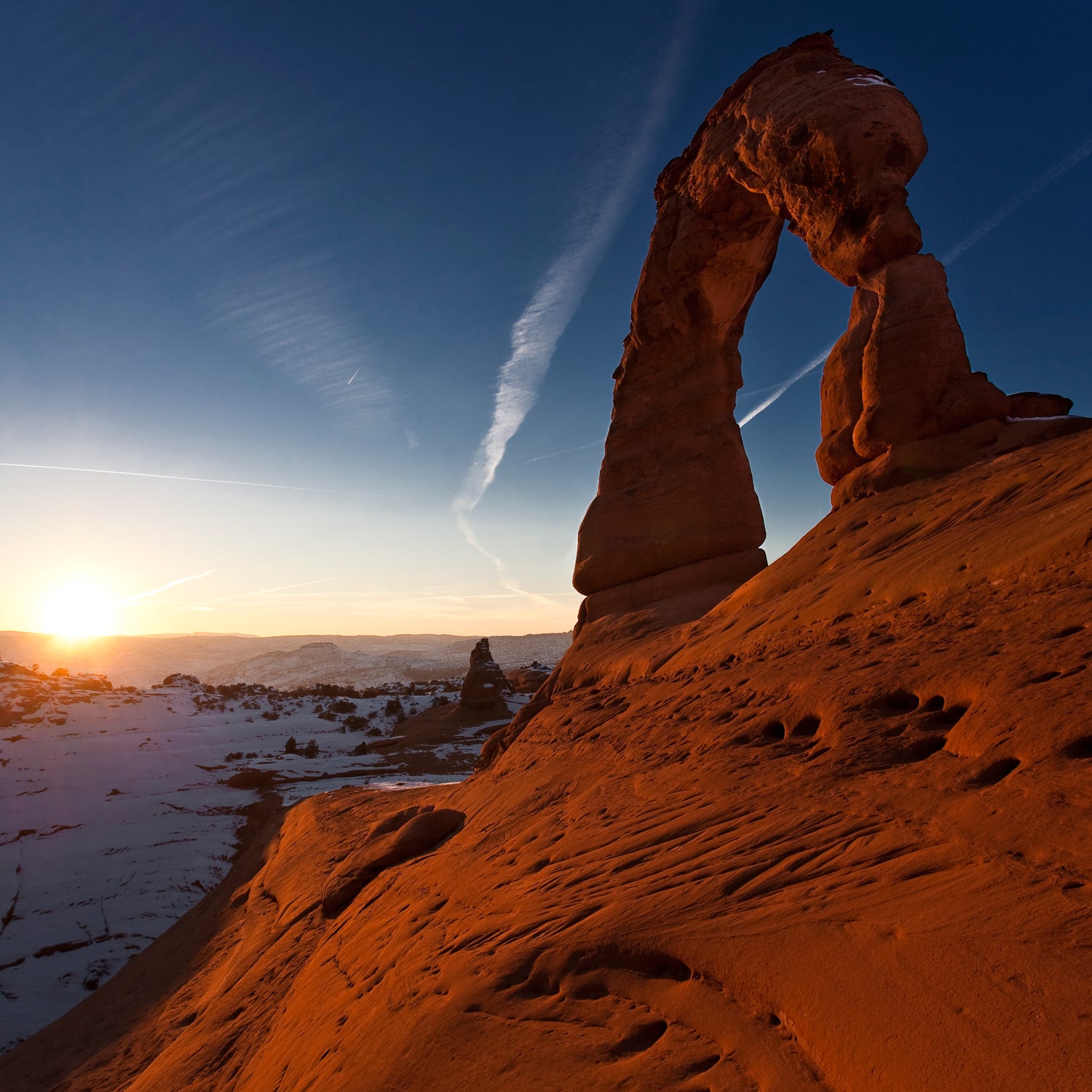What did Dean Potter do on Delicate Arch, and how did he do it?
The Dean Debate
on whether or not you think Dean Potter should have climbed Delicate Arch, then see the current poll standings.Delicate Arch
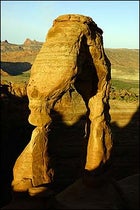 Delicate Arch, a marquee rock formation in Utah's Arches National Park.
Delicate Arch, a marquee rock formation in Utah's Arches National Park.Delicate Arch
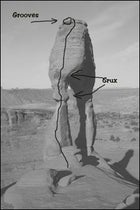 Dean Potter's approximate route up Delicate Arch's east side. On the upper left is the area where groove marks are visible in the sandstone.
Dean Potter's approximate route up Delicate Arch's east side. On the upper left is the area where groove marks are visible in the sandstone.Delicate Arch
 A wider view of the damaged sandstone.
A wider view of the damaged sandstone.Delicate Arch
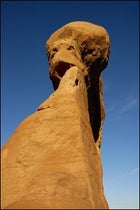 Potter's route as it appears from the base.
Potter's route as it appears from the base.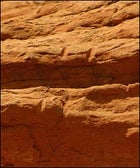 A close-up of the grooves.
A close-up of the grooves.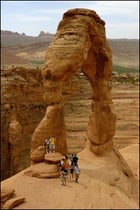 Tourists at the base of 60-foot-tall Delicate Arch.
Tourists at the base of 60-foot-tall Delicate Arch.Those questions have percolated in the climbing world since May 7, when Potter, a 34-year-old professional climber who splits his time between Moab, Utah, and Yosemite National Park, scampered to the top of Delicate Arch, a fragile landmark in southern Utah's Arches National Park. Potter's climb touched off a storm that has led to condemnation from close friends and mentors, virulent criticism from many climbers, and strict new climbing regulations in the park itself. What has remained a mystery, though, is exactly how Potter conducted the climb, and whether it was quite as delicate as many believe. As ���ϳԹ��� has learned, it wasn't, and there's even a chance Potter did permanent damage to Delicate Arch's famously soft sandstone.
Potter is best known for risking do-or-die routes with no protective gear to catch a fall. And if you saw the footage he released to TV newspeople immediately after the Delicate Arch climb, you saw a bare-chested daredevil going up one side alone,
That may depend on how you define “purest.” Extensive interviews with Potter, two friends who helped him video the climb, an ���ϳԹ��� editor who was present for the latter portion of the episode, Arches officials, climbers, supporters, and critics paint a different picture. Though Potter did free-solo Delicate Arch (as many as six times), he rehearsed the moves first, with protection from a top rope draped over the formation. Two men who accompanied him during the adventure, Brad Lynch, 35, and Eric Perlman, 55, ascended fixed ropes to the top. At least one of them captured Potter's moves on video. Some of that footage was included in a trailer for Potter's new movie, tentatively titled Aerialist, which aired before audiences at last weekend's Telluride Mountain film festival. ���ϳԹ��� saw a copy of the trailer, and it leaves no doubt Potter wasn't by himself atop the arch. One shot is taken from directly overhead while he's making an ascent.
As of midweek, Park Service investigators declined to say whether they had found signs of damage to the arch. But a photographer dispatched by ���ϳԹ��� who used a telephoto lens to take pictures of the area directly above Potter's route identified three distinct grooves worn by rope into the sandstone. (Each appears to be roughly a fourth of an inch deep and several inches long and is invisible to the naked eye from ground level.) In addition, Jason Keith, a Moab-based policy director with the Access Fund, a climber-advocacy group, says that, out of curiosity, he examined the arch in mid-May with a spotting scope and saw as many as five additional grooves that are visible on a different spot near the summit.
Arches officials have decided Potter's climb was not illegal, due to vaguely worded regulations that have since been made crystal clear to prohibit any more arch climbs. But according to Karen McKinlay-Jones, the park's acting chief ranger, officials are looking for damage to Delicate Arch with “a priority over everything except life and limb.” (She wouldn't comment further on how they're investigating.) The park's superintendent, Laura Joss, adds, “If there is damage to Delicate Arch, that is of grave concern to us.”
Rick Ridgeway, vice president of communications at Patagonia, one of Potter's main sponsors, says the company is “adamantly opposed” to acts that damage any natural setting and that it would likely reevaluate its relationship with Potter, one of Patagonia's top-ten paid athletes, if it turns out his climb damaged the formation. In any event, Ridgeway says it's now incumbent upon Potter to come clean about exactly what he did. “To say that he was just there to commune with nature is half the story,” he says. “It's time to be frank.”
Potter insists the climb left no trace. “The marks up there are not mine, absolutely, and I know for a fact that other people have been up there,” he says. “So it's crystal clear: When we were doing this arch climb it was in all of our minds that the super priority was to be careful of the rock: Don't harm the rock, move slowly, don't do anything at all if you are going to harm the rock. I'm so in tune with rocks and nature. On any rock around the world, if I hurt the rock, I feel like I'm hurting myself.”
Malcolm Daly, the 51-year-old founder of climbing-gear company Trango and a friend of Potter's, says any potential damage to the arch is a “tragedy.” But another issue for him, he says, is one of profound disappointment, and it cuts deeper than a rope groove. After first supporting Potter and getting roasted for it on climbing Web sites like , Daly has now become a critic.
“There are many people who think Dean just walked up there and climbed it,” Daly says. “I wanted to think that, because I have all this respect for him and this spiritual context under which he says he climbs. And I think other people want to believe that. That's why I feel so hurt. He did rehearse it. It was for a photo shoot. It was a communal effort by a group of people, and there is damage to the arch. It takes all the polish off the diamond.”
That this rock-jock feud started in Arches is curious, because it's not a great place for climbing. The rock in the park, a 78,000-acre expanse just north of Moab, is mostly entrada sandstone, a terrifyingly soft and brittle material that crumbles easily.
But the soft rock is also what makes Arches so special. Millions of years of wind and weather have coaxed some 2,000 natural arches and bridges from the Colorado Plateau. Many of these arches are so supremely crafted, huge wisps of bright red rock stretched across the desert sky, that geological terms don't seem sufficient. Brad Lynch says they're like “performance art,” especially when a climber moves up them.
Park officials don't want climbers on the arches for one very obvious reason: They're fragile. “I've done some climbs on sandstone where one rappel left a half-inch groove in the rock,” says Jimmie Dunn, a 57-year-old climber and longtime friend of Potter's. “A rope sliding down picks up specs of rock and acts as sandpaper.”
For years, “arch baggers” have risked fines and spectacular falls to climb along these desert curves, stealthily scaling formations in the hinterlands, far from the gaze of Arches rangers and nearly 800,000 tourists each year.
In initial reports about the climb, Potter said he'd been looking at Delicate Arch for 12 years, likely studying its nubs and ripples, visualizing ways to link them to the top.
But Potter's eye led him to the more pleasing east leg, a spindly drip of ancient dune that's no more than three feet thick at its skinniest point. Just above that narrow section, the line rears back in a slightly overhanging and rather featureless bulge, which starts about 20 feet up. To get through this crux, Potter had to tap his incredible strength and balance. “I can climb 5.11,” Lynch says, “and it looked harder than that.” To Potter's left, the ground rolled away steeply. Even if he survived a fall off the arch, he likely would have bounced, then slid down and over a 300-foot cliff.
Lynch says he was in the Moab area shooting footage for a BASE-jumping movie when he learned Potter was thinking of climbing Delicate Arch. Lynch proposed that they video the climb and says Potter was unsure at first. “It took a little bit of convincing,” he says. “I said, 'If you're going to do it, I want to shoot it.' We film everything we do. We just happen to be super-bitchin' at it.” Potter agreed.
On May 6, around 10:30 p.m., the two left the Potter home in Moab to check out Delicate Arch. They drove into the park and hiked the 1.5-mile trail from the parking lot up an incline to the formation. With few or no places to slot protective gear like nuts or cams, and with the distinct possibility of ripping off a hold, the men decided they needed to put a rope over the top first. Exactly how they did that is still a mystery, a secret that neither Potter nor Lynch will reveal, with Lynch coyly calling it “an old magician's trick.”
But there are theories. One easy way is a method that's been used by desert climbers for decades: shooting an arrow over the arch with a string attached, then using that string to haul up a heavier climbing rope. It's a common technique, but it's illegal in a national park, and Lynch strongly denies that this was the trick. “We did not use a freaking bow and arrow,” he says. “That's the obvious thing you think of, but no.” Another theory: They used a “monkey's fist,” basically a wadded knot of rope that one could conceivably launch with an oversize slingshot or whack with a bat over the arch.
Potter won't cop to that, either. “I'm not going to tell people how to do it, because I do think that only the most experienced people should take on climbs of that magnitude,” he says.
However the Magic Potter Rope was placed, Lynch weighted one end of it while Potter affixed a Petzl Mini Traxiona self-ratcheting pulley, tethered to his harness, to the other. That tool allowed Potter to climb up the rock freely, with the Mini Traxion slipping along the stationary rope. Should Potter fall, the gizmo would instantly cam, automatically pinching the rope and stopping him from rocketing down the face. That way, Lynch says, the rope wouldn't “saw” across the rock as it might with a traditional top-rope rigging.
Potter climbed the face, choosing to use small depressions in the rock for holds rather than breakable nubs. Following the blue cone of light from a headlamp, he reached the top without a hitch. Once there, Lynch says, Potter set up an anchor with four cams stuck in a horizontal crack in the cap of harder rock on the summit. He says Potter fed the rope off the top along a crack to prevent the rope from rubbing the rock. Lynch then affixed a similar camming device to the rope and climbed up the cord like an inchworm, dangling in space beneath the summit. The top isn't big, maybe 30 feet long by ten feet wide, and it rolls sharply to either side like a donut stuck in the sand. Lynch says he and Potter sat there for “hours, an hour, who knows,” watching shooting stars rip across the clear Utah sky.
“We were all alone, just me and him,” Potter says. “It was beautiful.”
Around 2:30 a.m., Potter called his wife, Steph, who was back at their Moab home with Katie Arnold, a friend and ���ϳԹ���'s managing editor. Arnold was visiting for the weekend and had no clue at that point that a Delicate Arch climb was under way.
Davis made coffee and soon she, Arnold, and Perlman, a writer and photographer, drove Perlman's rented Toyota Corolla into the park, just as day began to seep into the eastern sky. When they arrived at the arch, Potter had finished rehearsing; it's unclear exactly how long he practiced, and no ropes were visibly dangling off the arch. Lynch and Potter sat on the rock next to a mound of gear. Steph gave them coffee. As the sun started to warm things up, Potter set off on his first solo ascent, his mane of hair flowing off his six-five frame. Perlman, Lynch, and Davis shot video and stills, while Arnold watched.
Every time Potter got to the top, he pulled a coil of thin rope from a pocket and lowered it off the side to haul up a climbing rope and harness. He rappelled off slowly. At one point, Perlman ascended the rope to capture video of his friend climbing up the steep east route from above. When they were done, everyone packed up and left. The Potters and Arnold went to breakfast. Exhausted, Dean fell asleep over an egg sandwich.
At first Potter's handler at Patagonia spread the word of his climb by calling the Salt Lake Tribune. Public outrage was immediate, though, especially in Utah, where many see Delicate Arch as a symbol for the state's wild beauty. The company's communications department took over and Potter retreated from public view.
Meanwhile, Park Service officials swiftly moved to close a loophole that Potter used to justify his climb. The regulations, which had been in effect since 1988, stated that rock-climbing routes “may be closed” on any arch named on detailed topographical maps. Two days after the climb, park officials changed the wording to say that all named arches are closed to climbing year-round.
They also passed two other regulations that officials insist were simply overdue and not a reaction against what Potter did: Henceforth, slacklining (tightrope walking, often on a long piece of webbing) will not be allowed in Arches, and the placement of new fixed anchors on new climbs is also prohibited. Many climbers blame Potter for both
“The fixed-anchor change means we basically can't do new routes in Arches anymore,” says Jimmie Dunn. “There's a lifetime's worth back there.”
Far more virulent was the critical hurricane that tore through the blogosphere. Some blamed Potter for trying to gain publicity (which is, after all, part of his job). In online forums like Mountain Project, other climbers debated his motives.”A spiritual adventure, my ass,” wrote user Phil Broscovak. “Om mani pahdme hooey!”
Others, like Utah climber Ken Cangi and Trango's Malcolm Daly, rose to Potter's defense. “Why are you trying to make a mountain out of a molehill?” Cangi asked one critic.
Indeed, compared with other indignities that the park's formations have suffered, a few rope marks might pale in comparison. There are deep rope gouges carved on crags like Owl Rock, a legal place to climb inside the park. Delicate Arch itself was damaged in September 2000 when Michael Fatali, a photographer, set a fire at the base to light a picture he wanted to take. Fatali was later convicted of damaging park resources and paid nearly $11,000 in fines and restitution.
But Dunn says the gripes about Potter's climb quickly roared to a level “beyond anything I can remember.” Stunned by the outcry, Potter sent out an urgent e-mail titled “I NEED HELP!” in which he included the e-mail address for Patagonia's CEO, Casey Sheahan, and asked people to write in on his behalf. Hundreds did, says Jen Rapp, a company spokesperson, but so did plenty of others who wrongly assumed Patagonia knew about Potter's plans in advance.
A former Patagonia employee familiar with the Ambassador program for professional athletes estimates that Potter probably earns at least $50,000 a year from the company to travel around doing slideshows, attend product-design meetings, and represent climbers on behalf of the brand. The Ventura, California-based company hires about 30 of these pros in a wide array of adventure sports, including seven other rock climbers, like Steph Davis and Katie Brown. The “shit storm” over Delicate Arch, Rick Ridgeway says, was a blow against Patagonia's reputation for having a strong environmentally oriented mission.
“Right after the climb, the official position we put out was that we had no position,” Ridgeway says. “Personally, I was opposed to that, as it was mealymouth.”
An upper-echelon debate at Patagonia ensued, Ridgeway says. Some execs felt the company should support Potter's stunt as an issue of climbers' rights, as long as he broke no laws and didn't damage the rock. Others believed the spirit of the law had been broken and that the company had to do something to soothe outraged climbers. On Friday, May 26, they came to an agreement: They would strongly urge Potter to issue a public apology, and to make it clear that he didn't perform the climb on behalf of Patagonia.
“We haven't given him an ultimatum,” Ridgeway says. “But we've come to a consensus. We want him to apologize.”
The thing that riles climbers most, says Dunn, isn't that Potter climbed Delicate Arch but, rather, that he flaunted the feat to the world, a move that embarrassed the Park Service and broke an unspoken trust that climbers had with officials to respect the intent of the law. “We all knew not to climb it, and Dean knew that, too,” says Dunn. “He had to put a flag on top. It makes me want to vomit.”
At first, Potter refused to talk about the Delicate Arch incident when ���ϳԹ��� contacted him in Yosemite over Memorial Day weekend. The next day he called back, saying he had not been pressured to speak on the record by Patagonia. He apologized, sort of, saying that he was “sorry that all this negativity has arisen from such a beautiful communion with nature,” that he should be allowed to take pictures of his exploits just like everybody else, and that, at the time, he saw “no reason legally or morally” that he shouldn't have climbed the arch.
“The voice of the community is important to me,” he said. “My views are not concrete. I'm open to change.” In a private e-mail exchange among colleagues, Potter also said climbing the arch represented his “freedom of expression.”
And that, insists Eric Perlman, is where the bickering should end.
“I can't speak for Dean, but I can say that if I were in his position, knowing that I had done the best that I could do and my motives were pure and my execution was pure in the highest style, if other people choose to misinterpret what I've done, that's their business,” he says. “I don't have to bow down and apologize for doing what I did just because you have an opinion that's counter to it.”


